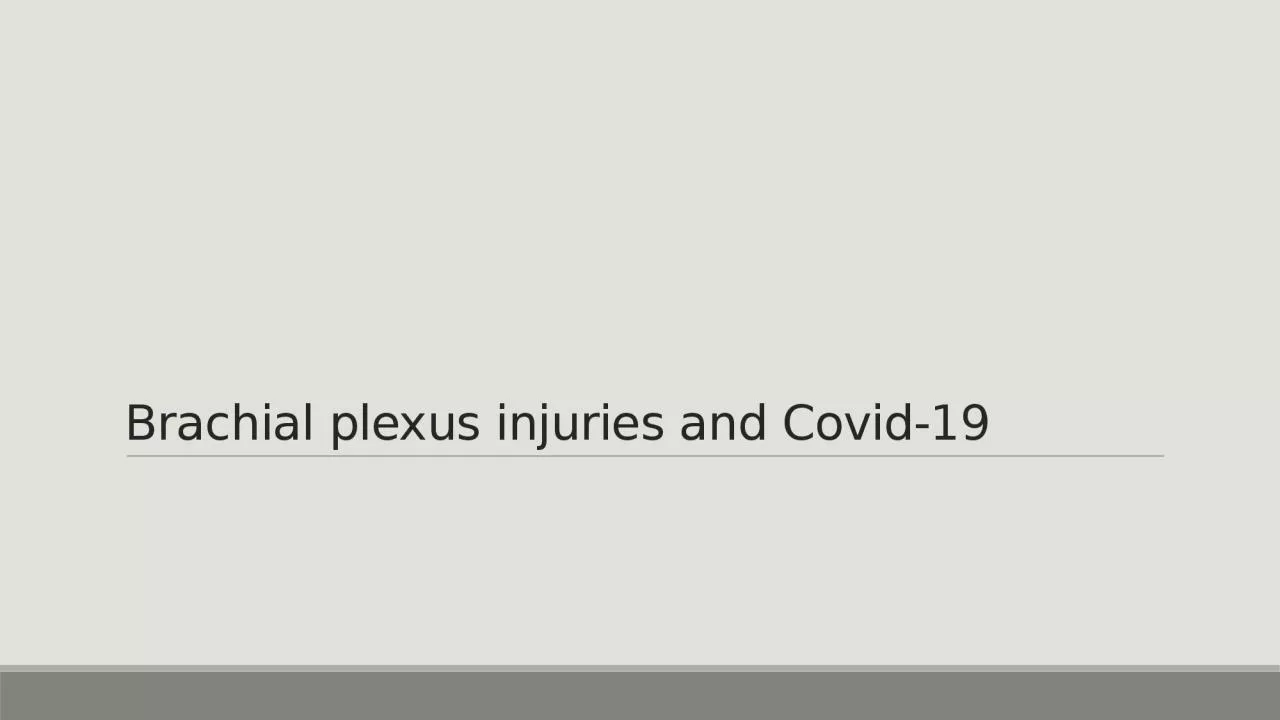

Aims To discuss current pathologies post Covid19 relevant to physiotherapy To review prone positioning and brachial plexus injury link To review brachial plexus anatomy and presentation Physiotherapy treatment ID: 999000
Download Presentation The PPT/PDF document "Brachial plexus injuries and Covid-19 " is the property of its rightful owner. Permission is granted to download and print the materials on this web site for personal, non-commercial use only, and to display it on your personal computer provided you do not modify the materials and that you retain all copyright notices contained in the materials. By downloading content from our website, you accept the terms of this agreement.
1. Brachial plexus injuries and Covid-19
2. Aims To discuss current pathologies post Covid-19 relevant to physiotherapy To review prone positioning and brachial plexus injury link To review brachial plexus anatomy and presentation Physiotherapy treatment Review current guidelines from Stanmore
3. Reason for current presentation Recent studies of patients with severe Covid-19 who have been hospitalised on ventilators have shown lying face down is better for the lungsThe study has found alternating supine and prone positioning is associated with increased lung recruitability compared to those who did not receive prone positioning and had poor lung recruitabilityPatients are spending prolonged periods in a prone position. There are risks associated with this include brachial plexus related injuries The national nerve injury unit (Stanmore) are getting a lot of queries about management of these patients and have developed recommendations to guide further treatment of patients who are getting altered upper limb neurology or Prone Position Plexopathy (PPP)
4. Brachial plexus anatomy The brachial plexus is a network of nerve fibres that supplies the skin and musculature of the upper limb Begins in the root of the neck, passes through the axilla, and runs through the entire upper extremityThe plexus is formed by the divisions of C5, C6, C7 and C8, and T1The brachial plexus is divided into five parts; roots, trunks, divisions, cords and branches (a good mnemonic for this: Read That Damn Cadaver Book)In the axilla and the proximal aspect of the upper limb, the three cords give rise to five major branches. The 5 major branches are the: the musculocutaneous nerves, axillary, median, radial and ulnar nerve There are also small nerve which come off the brachial plexus at different areas e.g. dorsal scapula nerve, long thoracic nerve
5. Anatomy video https://www.youtube.com/watch?v=5YJJkK4Kw88
6. Musculocutaneous NerveRoots: C5, C6, C7.Motor Functions: Innervates the brachialis, biceps brachii and coracobrachialis muscles.Sensory Functions: Gives off the lateral cutaneous branch of the forearm, which innervates the lateral half of the anterior forearm, and a small lateral portion of the posterior forearm.Axillary NerveRoots: C5 and C6.Motor Functions: Innervates the teres minor and deltoid muscles.Sensory Functions: Gives off the superior lateral cutaneous nerve of arm, which innervates the inferior region of the deltoid (“regimental badge area”).
7. Median NerveRoots: C6 – T1. (Also contains fibres from C5 in some individuals).Motor Functions: Innervates most of the flexor muscles in the forearm, the thenar muscles, and the two lateral lumbricals associated with the index and middle fingers.Sensory Functions: Gives off the palmar cutaneous branch, which innervates the lateral part of the palm, and the digital cutaneous branch, which innervates the lateral three and a half fingers on the anterior (palmar) surface of the hand.Radial NerveRoots: C5 – T1.Motor Functions: Innervates the triceps brachii, and the muscles in the posterior compartment of the forearm (which are primarily, but not exclusively, extensors of the wrist and fingers).Sensory Functions: Innervates the posterior aspect of the arm and forearm, and the posterolateral aspect of the hand.
8. Ulnar NerveRoots: C8 and T1.Motor Functions: Innervates the muscles of the hand (apart from the thenar muscles and two lateral lumbricals), flexor carpi ulnaris and medial half of flexor digitorum profundus.Sensory Functions: Innervates the anterior and posterior surfaces of the medial one and half fingers, and associated palm area.
9. Causes of brachial plexus injuries Prone lying for prolonged periods with patient who have Covid-19 Traction due to extreme movements and heavy impact Shoulder trauma or surgeries Tumours Inflammation Obstetric injuries during birth e.g. excessive stretching of the neck or pulling the upper extremity Vascular injuries
10. Signs and symptoms WeaknessNumbness Altered sensation Loss of movement Pain- electric shock/burning sensation down arm Longer term patients can suffer with stiffness in joints, muscle atrophy, pain becoming more chronic, permanent numbness and permanent loss in function
11. PresentationUpper brachial plexus lesion Occurs from excessive lateral neck flexion away from the shoulderForceps delivery or falling on the neck at an angle causes upper plexus lesionLeads to Erb's PalsyProduces a Waiter's tip deformity due to loss of the lateral rotators of the shoulder, arm flexors, and hand extensor muscles.Lower brachial plexus lesion Infrequently Sudden upward pulling on an abducted arm e.g. grasping a tree branch suddenly when falling C8 and T1 injured Paralysis affects the intrinsic muscles of the hand and the flexors of the wrist and fingers Results in a form of paralysis known as Klumpke's Paralysis
12. Treatment Depends on the severityPhysiotherapy aim is to develop strength, ROM and co-ordination Positioning and splinting may be required in some cases Functional training Acupuncture TENS machine Managing chronic odema (education, compression garments, massage therapy)Neuropathic medication e.g. NSAID's, neuropathics Surgery in some cases Psychological well being and management
13. ExercisesMay include: Scapula stability Off loading Biceps/triceps/wrist strengthening Grip strength Nerve glides
14. Physiotherapy treatment/exercises ROM: Assisted, Active Assisted, Active.Graded progressive strengtheningStrength: Isometric, Eccentric, Concentric. Manual Therapy Techniques: Cx distraction, soft tissue massage, Collar & Cuff, Taping, Nerve Glides/slides.
15. Current treatment/Recommendations in line with Covid-19From the royal orthopaedic association – Stanmore
16.
17. Suggested clinical examination tool
18. Resources used https://www.gmjournal.co.uk/covid-19-prone-position-in-icu-better-for-lungshttps://www.boa.ac.uk/policy-engagement/journal-of-trauma-orthopaedics/journal-of-trauma-orthopaedics-and-coronavirus/a-commentary-on-prone-position-plexopathy.htmlhttps://teachmeanatomy.info/upper-limb/nerves/brachial-plexus/https://www.physio-pedia.com/Brachial_plexushttps://www.mayoclinic.org/diseases-conditions/brachial-plexus-injury/symptoms-causes/syc-20350235https://pedclerk.bsd.uchicago.edu/page/brachial-plexus-injury